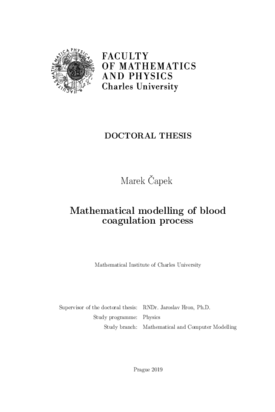Mathematical modeling of blood coagulation process
Matematické modelování procesu koagulace krve
dizertační práce (OBHÁJENO)

Zobrazit/
Trvalý odkaz
http://hdl.handle.net/20.500.11956/110658Identifikátory
SIS: 85537
Kolekce
- Kvalifikační práce [10690]
Autor
Vedoucí práce
Oponent práce
Bodnár, Tomáš
Lukáčová Medvídová, Mária
Fakulta / součást
Matematicko-fyzikální fakulta
Obor
Matematické a počítačové modelování
Katedra / ústav / klinika
Matematický ústav UK
Datum obhajoby
24. 9. 2019
Nakladatel
Univerzita Karlova, Matematicko-fyzikální fakultaJazyk
Angličtina
Známka
Prospěl/a
Klíčová slova (česky)
koagulace krve, mechanika biotekutinKlíčová slova (anglicky)
blood coagulation, FEM, biofluid mechanicsV předložené práci se věnujeme studiu procesu koagulace krve z hlediska matematického modelování. Koagulace krve sestává z vazoskonstrikce, primární asekundární hemostáze a fibrinolýzy. V práci je modifikován Stortiho model primární hemostáze nahrazením ALE formulace phase-field metodou prosledování rozhraní mezi sraženinou a tekoucí krví. Stortiho model je obohacen přidáním možnosti aktivace krevních destiček vyššími hodnotami smykového napětí kromě aktivace krevních destiček chemickými sloučeninami - tromboxanem, ADP nebo trombinem. Na rozdíl od Stortiho modelu je použit také nenewtonovský model krve. Používáme dva přístupy pro modelování sraženiny. V prvním přístupu je sraženina modelována jako newtonovská tekutina s vysokou viskozitou. V druhém přístupu se předpokládá, že sraženina je viskoelastický material, jehož reologické vlastnosti procházejí vývojem dle Kempenova modelu. Phase-field metoda byla také aplikována na Wellerův model hemostáze vyvolané vysokými hodnotami smykového napětí. Weller využil cylindrické symetrie výpočetních oblastí, čímž výpočty redukoval na dvourozměrné problémy. V této práci byly provedeny výpočty na trojrozměrných výpočetních oblastech za použítí knihovny deal.ii. Je plně využita její schopnost distribuovat výpočty na větší počty výpočetních jednotek...
On vessel wall injury the complex process of blood coagulation is set off. It is composed of vasoconstriction, primary hemostasis, secondary hemostasis and fibrinolysis. This work enriches current model of primary hemostasis of Storti. The previous model used ALE formalism for tracing of development of platelet plug. The phase field method is used for tracing of the development of interface blood-thrombus. Storti's primary hemostasis was extended to capture the fact, that the platelets can be activated in the blood flow in the area of reactive surface not only by influence of chemical agents like thromboxane, ADP and thrombin but also by their exposure to elevated values of shear stress. In our first approach we deal the emerging thrombus as a fluid with very high viscosity. In the second approach it was assumed, that platelet plug develops as a viscoelastic material according to constitutive equations of clot introduced by Kempen. In this manner platelet clot matures into blood clot. In both approaches the blood is represented as a non-Newtonian fluid. The framework of the phase field method was applied also to the model of high shear rate thrombosis of Weller. Weller's original model of Weller took advantage of the cylindrical symmetry of computational domains for its computations, hence the...
